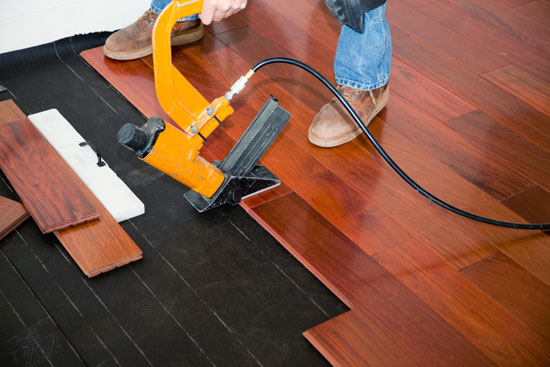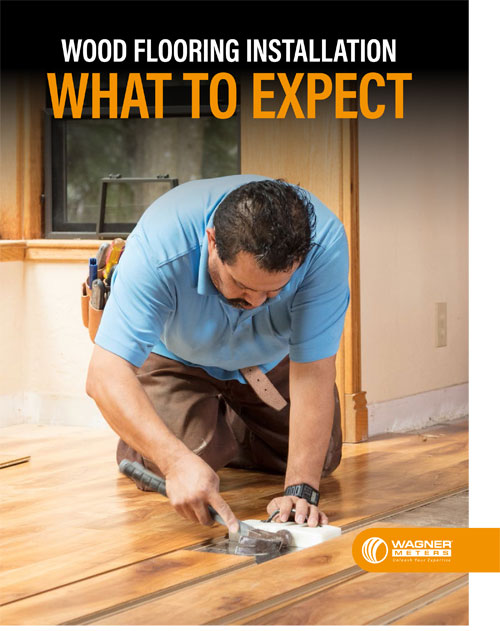Engineered Flooring Installation on Concrete – pt2
Engineered Flooring Requires Acclimation
Just like solid hardwood flooring, engineered flooring needs to be acclimated to its environment before installation. Consult the specific manufacturer for their acclimation process.
Do not store engineered wood flooring in basements or garages where humidity levels are higher.
To allow for proper acclimation, the heating/air-condition system must be operational for least 14 days prior to installation and thereafter at a temperature of 65°F – 75°F to reach desired humidity level. The relative humidity level at home should be controlled between 35% – 55% at all times prior, during and subsequent to installation.
To ensure the flooring is properly acclimated and has achieved equilibrium moisture content (EMC) with the surrounding ambient conditions, you need to measure the MC in the wood planks. Whether installing on a concrete or wood substrate, always reference the NWFA Installation Guidelines for the appropriate method of installation.
According to the National Wood Flooring Association (NWFA) guidelines, moisture readings of the subfloor should be no more than 13% on average (more common in humid geographic regions). And, depending on the flooring manufacturer’s installation guidelines, there should be no more than 2% MC to 4% MC difference (depending on flooring plank width) between properly acclimated wood flooring and the subfloor.
Tip: Test the subfloor moisture in several locations taking note of higher readings. Higher readings indicate a moisture problem that needs to be addressed before installation can begin.
Concrete Moisture Measurement
If a contractor plans to install a wood subfloor above a concrete slab in a new or existing home, it’s wise to first measure the moisture conditions within the slab. Excessive moisture in a slab can damage a wood subfloor and, in turn, an engineered wood floor, causing the plies to separate.
To accurately assess moisture conditions in a concrete slab, the ASTM F2170 relative humidity (RH) test is preferred. This test uses sensors or probes to measure the RH at a specific depth within the concrete – 40% of the slab’s thickness for a slab drying from one side, or 20% for a slab drying from two sides.
Scientific research confirms the reliability and accuracy of the RH test at these depths. The readings will most accurately predict the slab’s point of equilibrium, and therefore the true moisture condition that will exist after the flooring installation.
Before installing a wood subfloor, a moisture barrier should be placed on the slab to protect the subfloor and the flooring from moisture.
How to Install Nail-Down Engineered Wood Flooring
 When there’s a wood subfloor in place in the form of plywood or OSB, then a nail-down or staple-down, rather than glue-down installation is the best way to go. Aside from a few specialty tools, it’s a cost-effective method requiring only nails or staples and an inexpensive moisture barrier underlayment, such as Aquabar “B” or Silicone Vapor Shield (SVS).
When there’s a wood subfloor in place in the form of plywood or OSB, then a nail-down or staple-down, rather than glue-down installation is the best way to go. Aside from a few specialty tools, it’s a cost-effective method requiring only nails or staples and an inexpensive moisture barrier underlayment, such as Aquabar “B” or Silicone Vapor Shield (SVS).
Required Tools
Nail-down installations require additional tools, including a specialty flooring nail gun, jamb saw, and router. These are essential to complete the job successfully.
You will also need a chalk line and nail set, power drill, nails and underlay paper, miter saw, table saw, back saw/door jamb cutter, safety glasses, and dust masks.
Since engineered wood flooring comes in various thicknesses, consult the manufacturer for the proper length and gauge fasteners. Each plank or strip should be nailed or stapled every 8” and 3” from both ends of the plank.
Jobsite Preparation
Installing wood flooring is usually one of the last jobs on any construction or remodeling project. The contractor, however, must resist pressure to speed up installation for any reason without taking the necessary precautions and steps to ensure a successful installation. Proper job site preparation includes:
- Always following the flooring manufacturer’s instructions to validate warranty requirements.
- Making sure the building is completely enclosed with interior heating and cooling systems running before the flooring material arrives, so as to bring the building to normal living conditions.
- Acclimating the flooring material to living conditions for 3-5 days after it arrives, or as specified by the manufacturer.
- Measuring the flooring planks and subfloor with a moisture meter for MC.
- Measuring a concrete slab for moisture in the event a subfloor is to be installed above the slab. The industry-preferred moisture test is the ASTM F2170 RH test.
Subfloor Preparation
- Subfloors should be clean, dry, stable, and flat (within 1/8” over a 6’ span and 3/16” over a 10’ span).
- Uneven subfloors can result in gaps, squeaks, and poor fitting planks during assembly. Screw down the subfloor securely to flooring joists to prevent squeaking occurring later.
- To achieve floor flatness, you may need to either belt sand/ground down or build up with a suitable floor leveling material.
- Use 30 lb. roofing felt, roofing shingles, or “firm” vinyl tile in layers to build up low areas.
- Never apply sheet plastic over wood subfloors.

Free Download – Wood Flooring Installation: What To Expect
Installation
For engineered flooring, the NWFA’s installation guidelines recommend manufacturer instructions be followed. If you use staples, space them every 3 to 4 inches apart and 1 to 2 inches from the end joints.
In most cases, the flooring is installed by blind-nailing the material through the tongue of the floorboards into the wooden subfloor. This hides the nails after the flooring is installed.
Once the final rows are reached, there will be no space to use the floor nailer or stapler on the tongue. It will then be necessary to nail by hand. Rip the last boards to fit leaving ½” gap from the wall. Pre-drill, top-nail, and nail set on the last row. Fill nail holes with putty. Cut any door jams and fit floor underneath. Install any required reducers at door thresholds.
Re-install baseboards and quarter-round, and fill any nail holes with the appropriate color of putty filler.
Nail-Down or Stapling
Nail-down and staple-down wood floor are the most common and preferred methods if the installation is over a plywood or OSB subfloor. It’s cost-effective and doesn’t require much more than nails or staples and an inexpensive moisture barrier underlayment. It’s a permanent installation.
With the right environment and maintenance, the chances of product failure are minimal. Should a board become damaged, replacement is seamless. Nail-down installations allow flush-in transitional moldings and vents to be used instead of overlap moldings and drop-in vents — providing the improved look and feel of a flush mount transition.
Manufacturer’s Specs
The last piece of advice is the most important: Learn, memorize, and follow the manufacturer’s specs for all parts of the install, but most especially regarding cleat, staple, or nail sizes. Whichever you use, make sure you have the right size stipulated by the manufacturer. Follow the specs and advice and you will be enjoying a beautiful look and feel of having a flush mount transition floor that will last generations.
For more information about engineered flooring moisture testing and concrete RH testing, call (541) 291-5123.
How to Install Glue-Down Engineered Wood Flooring on Concrete
Previously published by Hardwood Floors Magazine
Tony Morgan is a senior technician for Wagner Meters, where he serves on a team for product testing, development, and also customer service and training for moisture measurement products. Along with 19 years field experience for a number of electronics companies, Tony holds a B.A. in Management and his AAS in Electronics Technology.
Related Posts via Taxonomies
Last updated on July 30th, 2021




Hey,
I was wondering is your engineered wood flooring compatible with underfloor heating?
Hi Fraser,
We don’t sell anyone hardwood flooring or engineered wood flooring. We sell moisture measurement products such as our Orion pinless wood moisture meter.
Thanks.